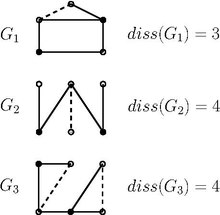Dissociation number

In the mathematical discipline of graph theory, a subset of vertices in a graph G is called dissociation if it induces a subgraph with maximum degree 1. The number of vertices in a maximum cardinality dissociation set in G is called the dissociation number of G, denoted by diss(G). The problem of computing diss(G) (dissociation number problem) was firstly studied by Yannakakis.[1][2] The problem is NP-hard even in the class of bipartite and planar graphs.[3]
An algorithm for computing a 4/3-approximation of the dissociation number in bipartite graphs was published in 2022.[4]
The dissociation number is a special case of the more general Maximum k-dependent Set Problem for . The problem asks for the size of a largest subset of the vertices of a graph , so that the induced subgraph has maximum degree .
Notes
[edit]References
[edit]- Yannakakis, Mihalis (1981). "Node-Deletion Problems on Bipartite Graphs". SIAM J. Comput. 10 (2): 310–327. doi:10.1137/0210022.
- Papadimitriou, Christos H.; Yannakakis, Mihalis (1982). "The complexity of restricted spanning tree problems". J. ACM. 29 (2): 285–309. doi:10.1145/322307.322309.
- Hosseinian, Seyedmohammadhossein; Butenko, Sergiy (2022). "An improved approximation for Maximum k-dependent Set on bipartite graphs". Discrete Appl. Math. 307: 95–101. arXiv:2110.02487. doi:10.1016/j.dam.2021.10.015.




![{\displaystyle G[S]}](https://wikimedia.org/api/rest_v1/media/math/render/svg/0723fcf9ef793da51344cad3ccf28810e01dd854)
